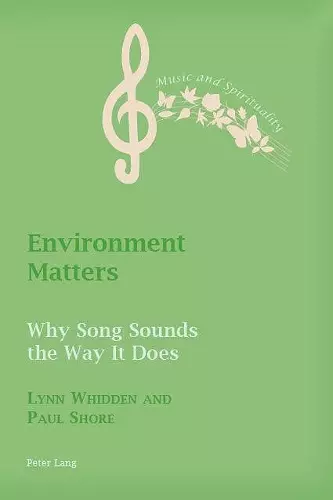Environment Matters
Why Song Sounds the Way It Does
Paul Shore author Lynn Whidden author June Boyce-Tillman editor
Format:Paperback
Publisher:Peter Lang International Academic Publishers
Published:11th Dec '18
Currently unavailable, and unfortunately no date known when it will be back

Why does human music sound the way it does? To better understand this, the authors look at the human and even animal ability for mimicry, at existing acoustic niches and introduce the idea of at least three habitats for music. Is there a unified sound quality for music created indoors, for song sung outdoors, and for music produced with electric signals?
Whidden and Shore seek answers from music ethnography, from the closed space of medieval churches, from Gothic architecture, from particular buildings such as the Prague Estates Theatre and from their own experience and that of others in the contemporary electronic music environment. Drawing on fieldwork, archival materials and media studies research, they propose a model that will inspire scholars to explore human music in its rightful and important place in the natural world.
«Whidden and Shore wrestle with a long-held recognition of the impact of surroundings on the resultant music created. Through the identification of three different Habitats, Outdoors, Indoors, and Electronic, they systematically investigate what this impact may be. Each Habitat is explored through detailed analyses including various Canadian Indigenous musics for the «Outdoors», and a consideration of Western notated [classical] musics emerging initially from European monasteries and churches for the «Indoors». They raise many interesting observations and queries after their consideration of the impact of electronics on music of the past century. In short, a masterful study initiated to some degree by the insights of Canadians, R. Murray Schafer and Daniel J. Levitin.» (Dr. Elaine Keillor, C.M. Distinguished Research Professor Emerita, Carleton University)
«Ethnomusicology and the study of music history so often get bogged down in minutiae that it is wonderful to see a pair of scholars from these different but related fields collaborating to develop an overarching vision of the ways in which the natural, built and electronic environments have influenced music-making over many centuries. […] Just as the size of medieval cathedrals had a massive impact on the evolution of medieval and Renaissance church music, resulting in complex polyphony, so the growing size of concert halls and opera venues in nineteenth-century Europe transformed «classical» music, facilitating Wagner's «Ring» and Mahler’s «Symphony of a Thousand.» We’ve seen a similar thing happen in twentieth-century popular music with the emergence of forms of rock music (e.g. heavy metal) designed for very powerful loudspeaker systems in huge auditoria. [This] work is important because it stimulates us to re-examine the ways different human environments have played diverse roles in influencing the initial creation of new musical forms and modifying their subsequent development. It’s a new way of looking at music history, and the possibilities are endless.» (Dr E. David Gregory, Professor Emeritus, Athabasca University)
«In this ground-breaking study, Whidden and Shore expand the discussion of «music» to include the associations that link music with the outdoors, the indoors, and electronic reproduction. These are the spaces where humans create, perform, and listen to music. Their systematic study has widened and deepened my understanding of musical experience.» (Lawrence Jones, DMA, Professor Emeritus, School of Music, Brandon University)
«Environment Matters is a fascinating study of the various habitats that frame music as we know it today. While the sounds of nature are the primary environment, man-made indoor music became our prevalent source of music, before the onset of electronic transmission and creation of sound catapulted our society into the modern world filled with the miracles and problems of applied technology. The book not only provides an analysis of this musical evolution, but also offers a highly interesting outlook on future developments. A must!» (Matthias Maute, conductor, composer, musician)
ISBN: 9781788744935
Dimensions: unknown
Weight: 407g
288 pages
New edition